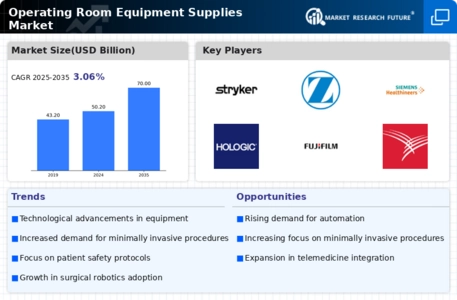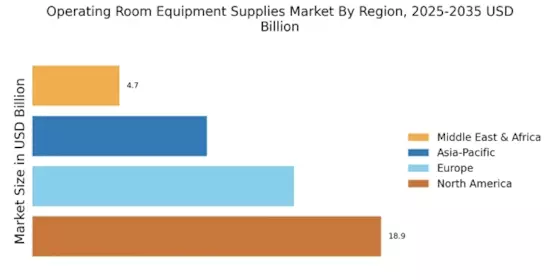Technological Innovations
Technological innovations play a crucial role in shaping the Operating Room Equipment Supplies Market. The advent of advanced surgical technologies, such as robotic-assisted surgery and enhanced imaging systems, has transformed traditional surgical practices. These innovations not only improve surgical outcomes but also enhance operational efficiency within the operating room. For instance, the integration of artificial intelligence and machine learning in surgical instruments is expected to streamline procedures and reduce the risk of complications. Market data suggests that investments in research and development for new surgical technologies are on the rise, further driving the demand for sophisticated operating room supplies. As hospitals and surgical centers seek to adopt the latest technologies, the market for operating room equipment is likely to experience substantial growth.
Rising Surgical Procedures
The increasing number of surgical procedures worldwide is a primary driver for the Operating Room Equipment Supplies Market. As healthcare systems evolve, the demand for surgical interventions continues to rise, driven by factors such as an aging population and the prevalence of chronic diseases. According to recent data, the number of surgical procedures is projected to grow significantly, leading to an increased need for advanced operating room equipment. This surge in demand necessitates the procurement of high-quality surgical instruments, anesthesia machines, and monitoring devices, thereby propelling the market forward. Furthermore, the expansion of outpatient surgical centers and advancements in minimally invasive techniques contribute to the growing requirement for specialized operating room supplies, indicating a robust market trajectory.
Regulatory Compliance and Standards
Regulatory compliance and adherence to industry standards are pivotal factors influencing the Operating Room Equipment Supplies Market. Healthcare facilities are required to meet stringent regulations set forth by health authorities, which dictate the quality and safety of surgical equipment. Compliance with these regulations not only ensures patient safety but also enhances the reputation of healthcare providers. As a result, there is a growing demand for certified operating room supplies that meet these regulatory requirements. Market data indicates that manufacturers are increasingly focusing on quality assurance and certification processes to align with regulatory standards. This trend is expected to drive the market as healthcare facilities prioritize the procurement of compliant equipment to mitigate risks and enhance operational efficiency.
Increased Focus on Infection Control
The heightened emphasis on infection control measures is a significant driver for the Operating Room Equipment Supplies Market. With the growing awareness of healthcare-associated infections, hospitals are prioritizing the implementation of stringent infection prevention protocols. This focus has led to an increased demand for sterile surgical instruments, disposable supplies, and advanced sterilization equipment. Market analysis indicates that the global market for infection control products is expanding, reflecting the urgent need for effective solutions in operating rooms. As healthcare facilities invest in high-quality supplies to ensure patient safety and compliance with regulatory standards, the operating room equipment market is poised for growth. The ongoing commitment to infection control will likely continue to influence purchasing decisions within the industry.
Growing Investment in Healthcare Infrastructure
The growing investment in healthcare infrastructure is a vital driver for the Operating Room Equipment Supplies Market. Governments and private entities are increasingly allocating funds to enhance healthcare facilities, particularly in emerging economies. This investment often includes the establishment of new hospitals and surgical centers, which necessitates the procurement of modern operating room equipment. Market Research Future suggest that the expansion of healthcare infrastructure is expected to continue, driven by the need for improved access to surgical services. As new facilities are built and existing ones are upgraded, the demand for high-quality operating room supplies will likely increase, thereby propelling market growth. This trend underscores the importance of infrastructure development in shaping the future of the operating room equipment market.


















Leave a Comment